Experimentally Based Model to Size the Geometry of a New OWC Device, with Reference to the Mediterranean Sea Wave Environment
Abstract
:1. Introduction
2. Wave Energy Map in the Mediterranean Sea
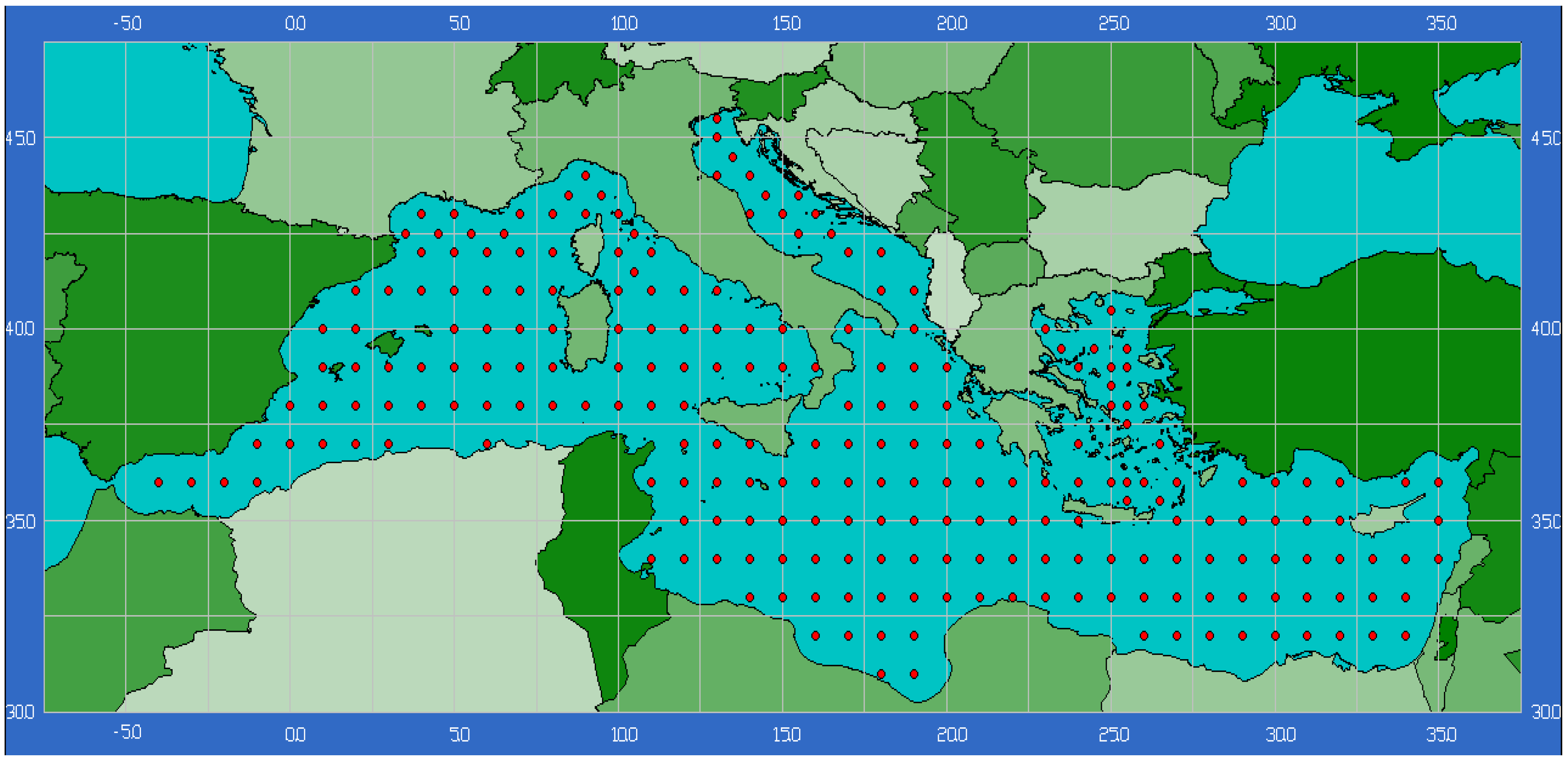
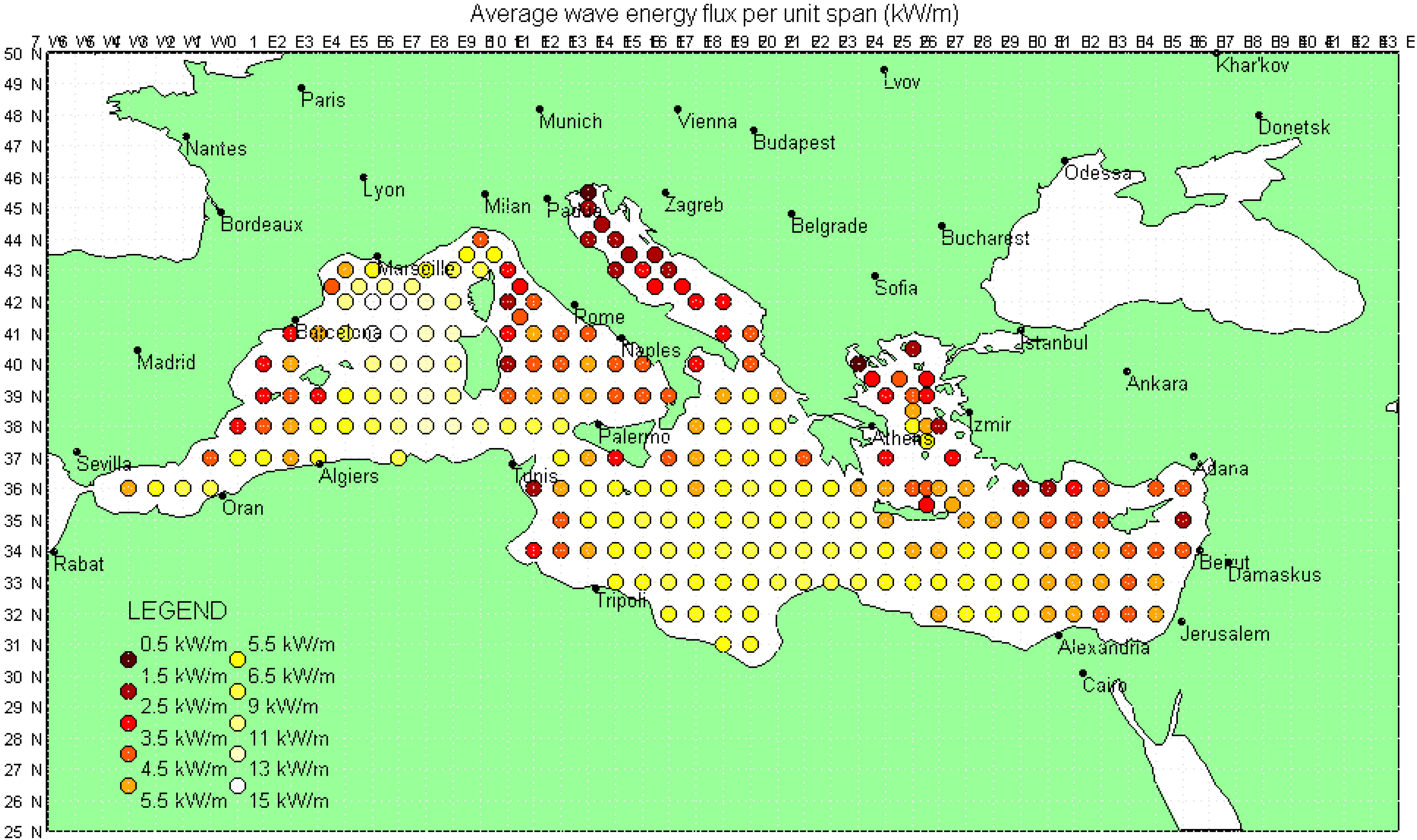

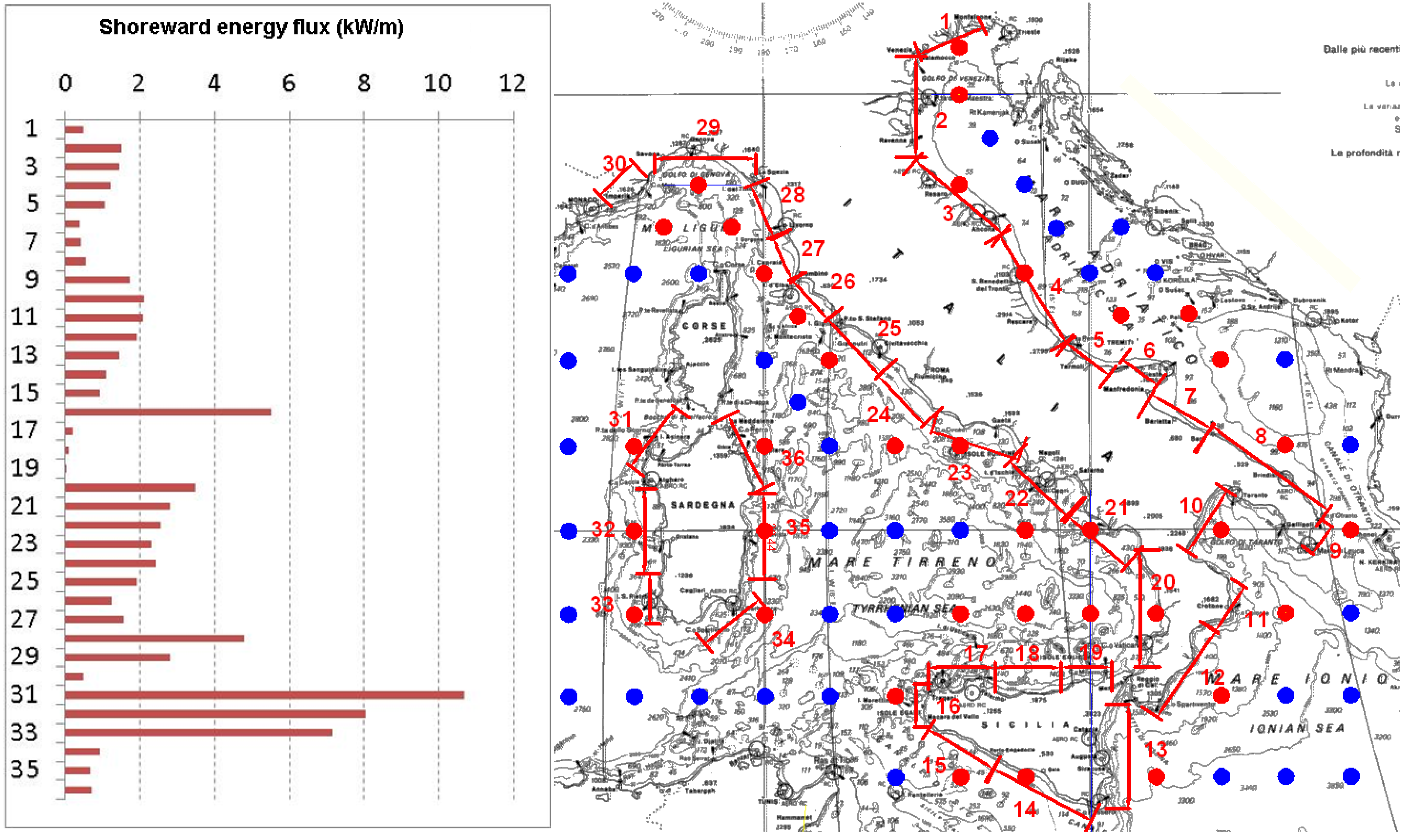
3. The Seabreath

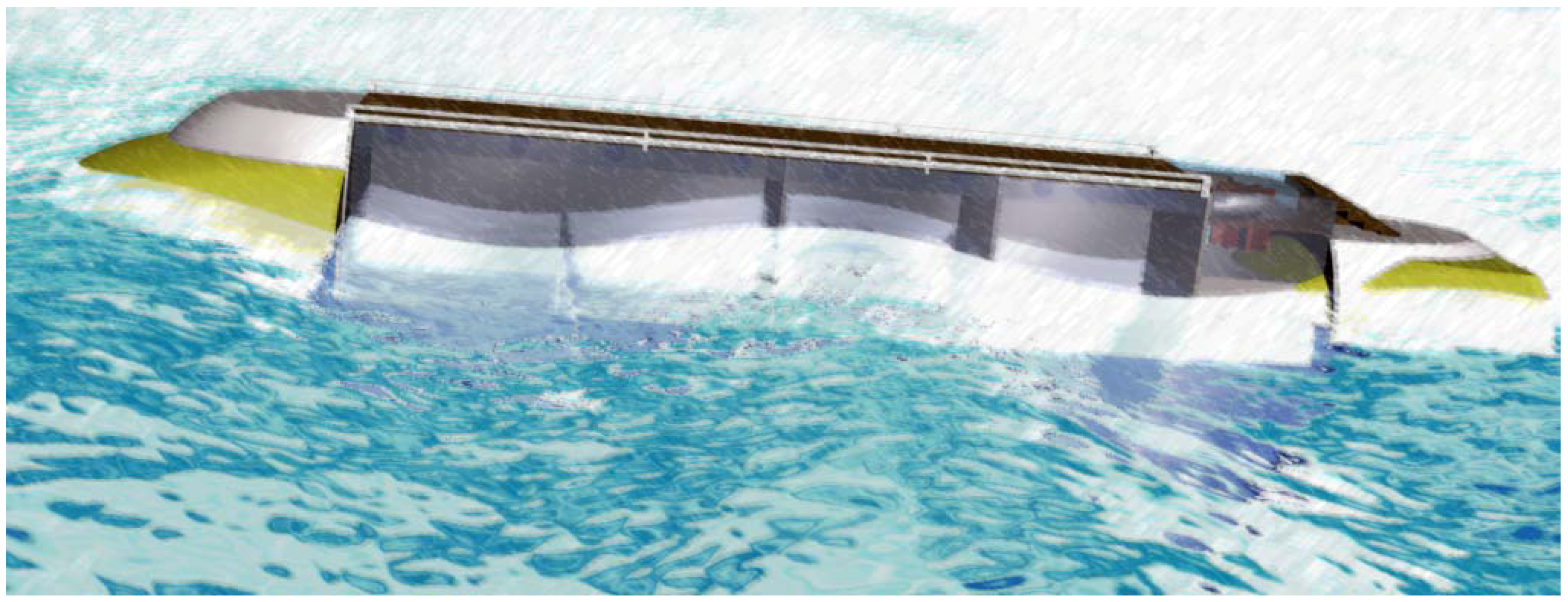
4. Physical Model Tests
4.1. The Facility
4.2. Motion of the Free Surface inside the Chambers
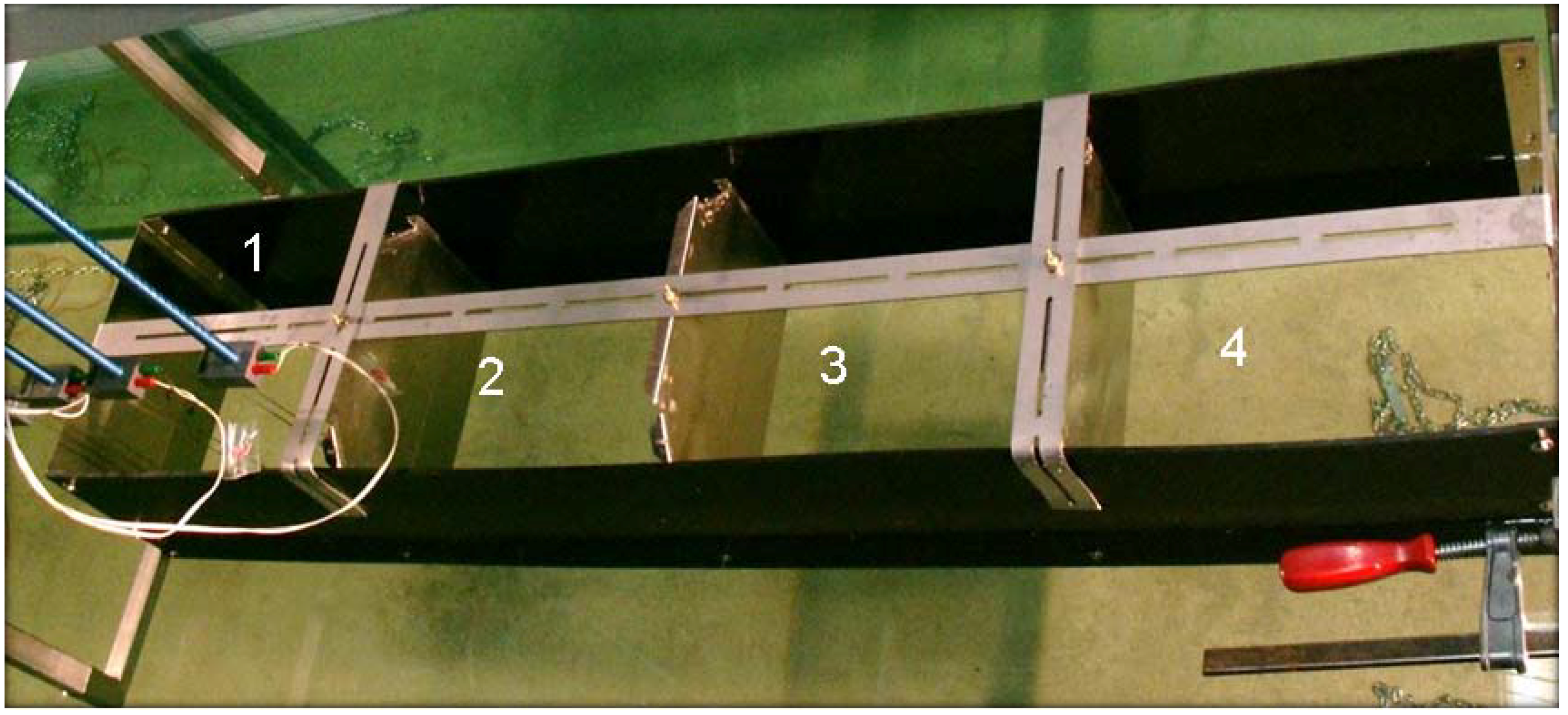
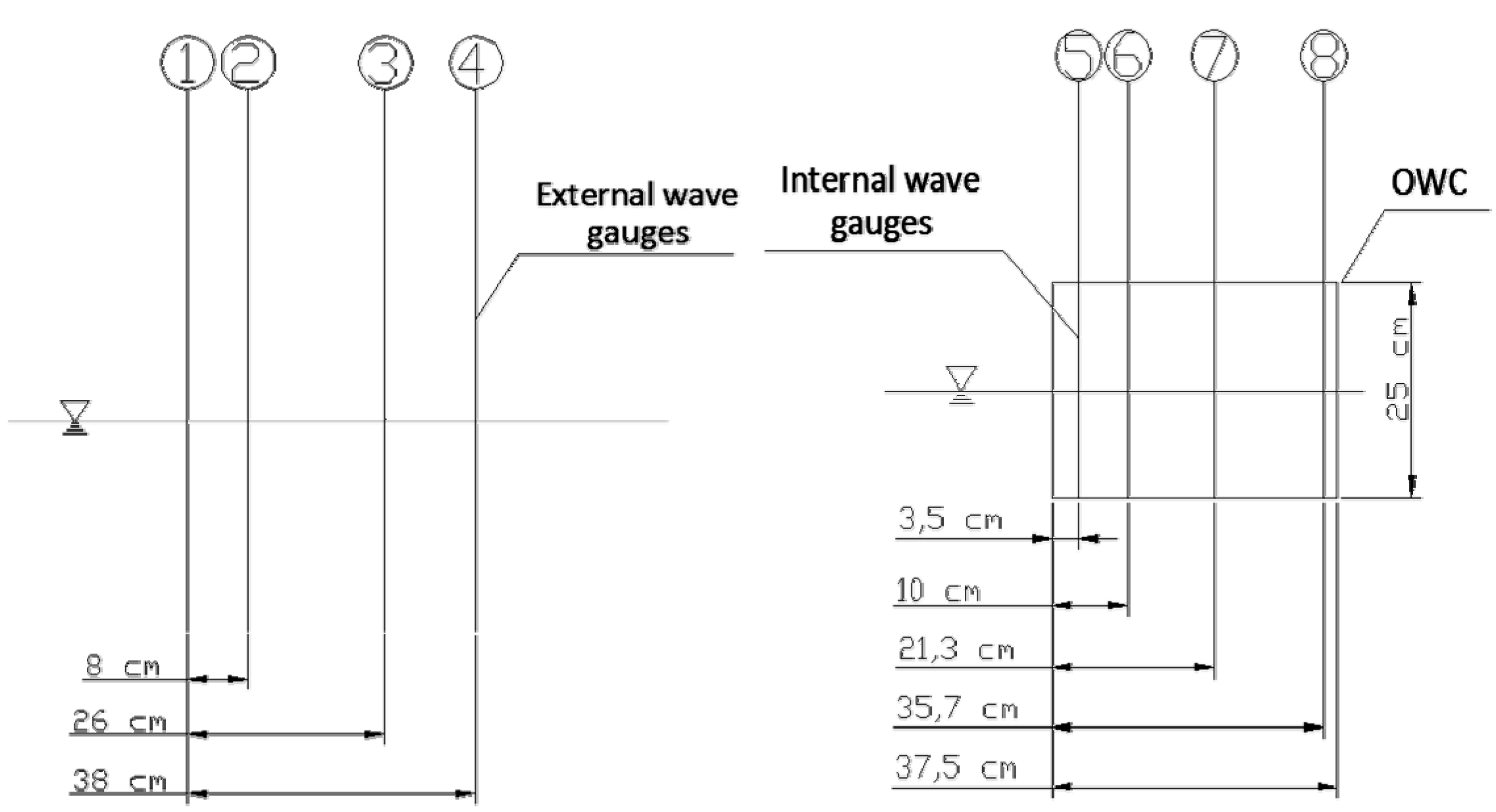


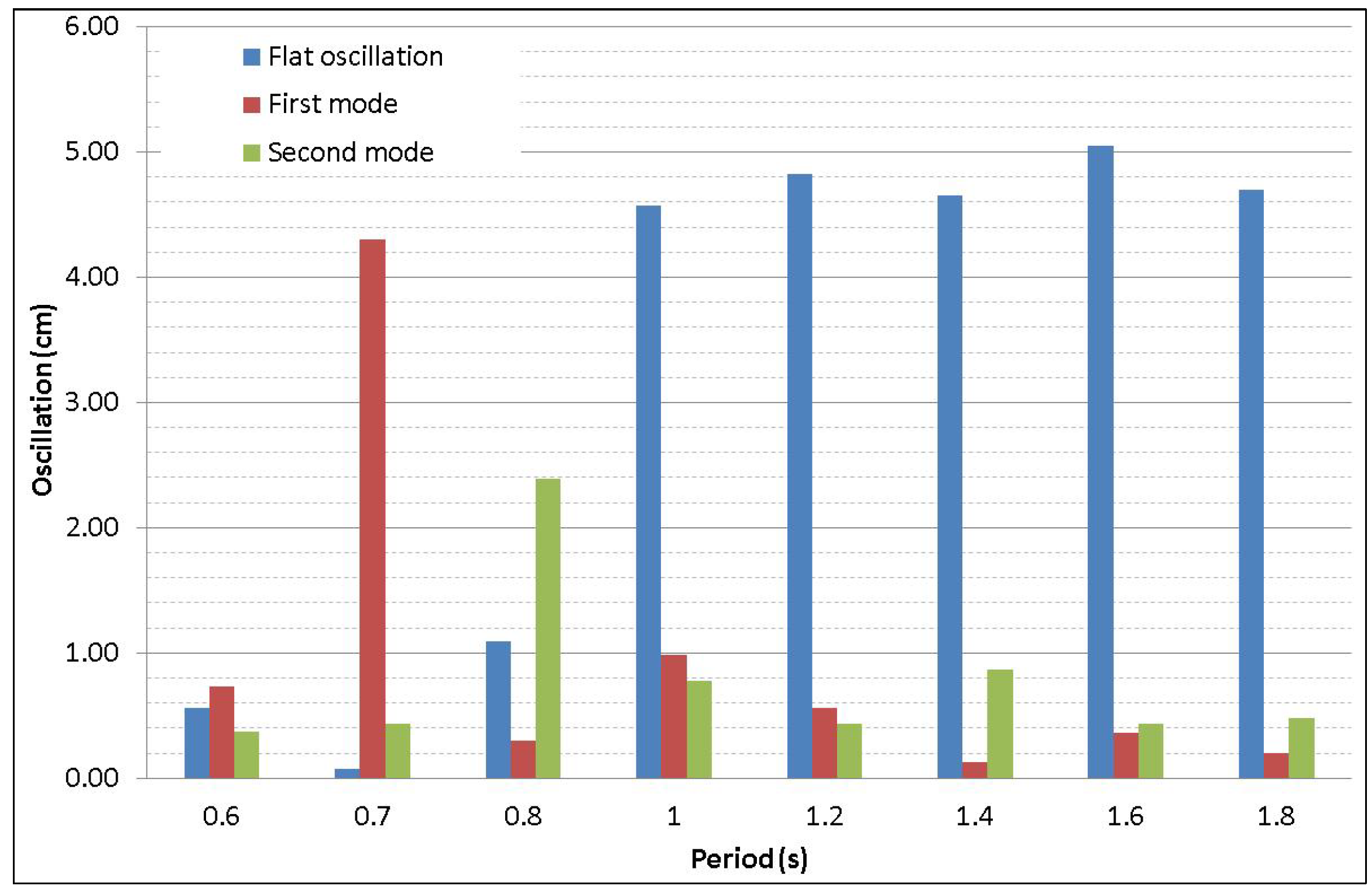
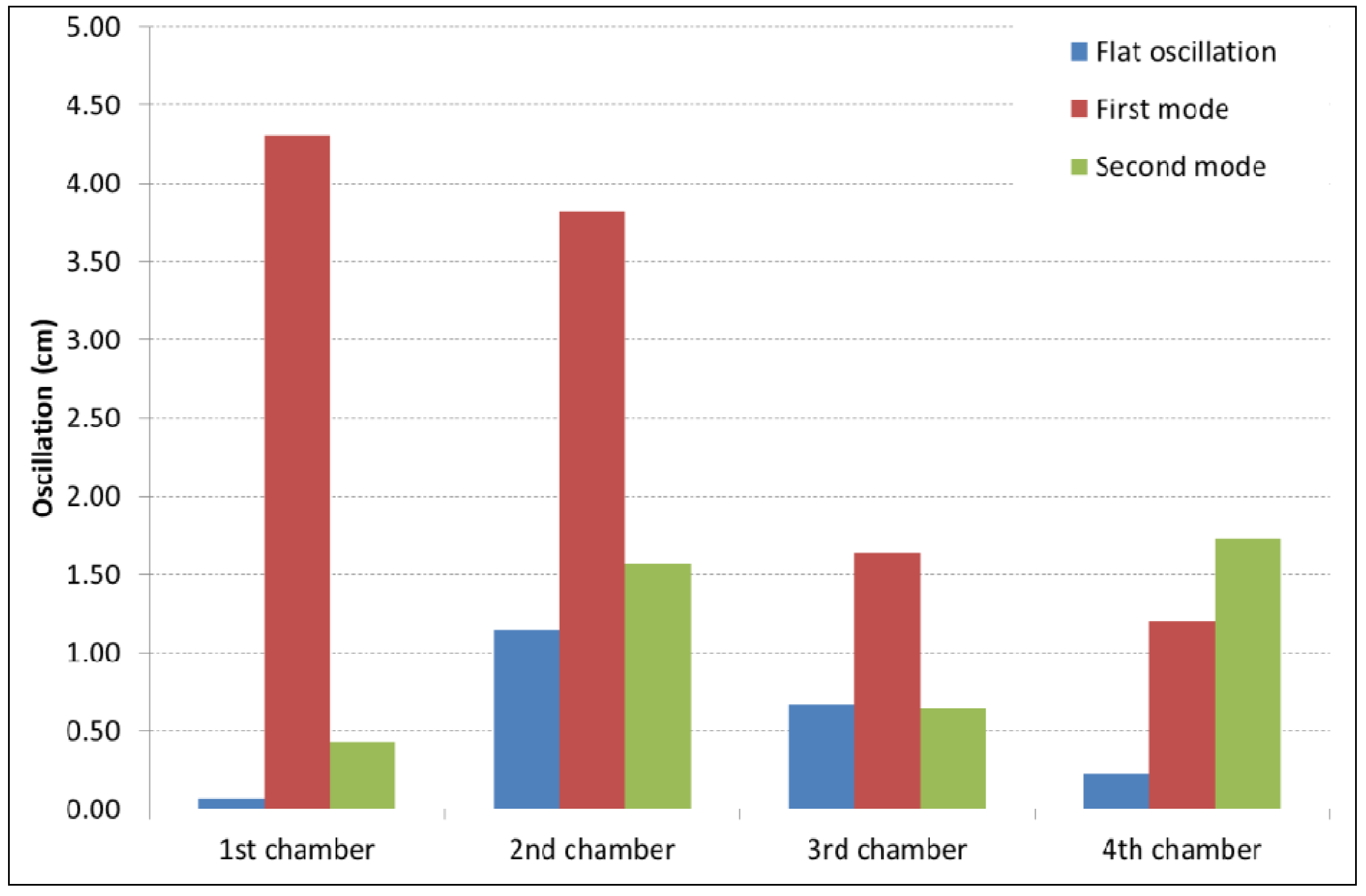
4.3. The Closed Model


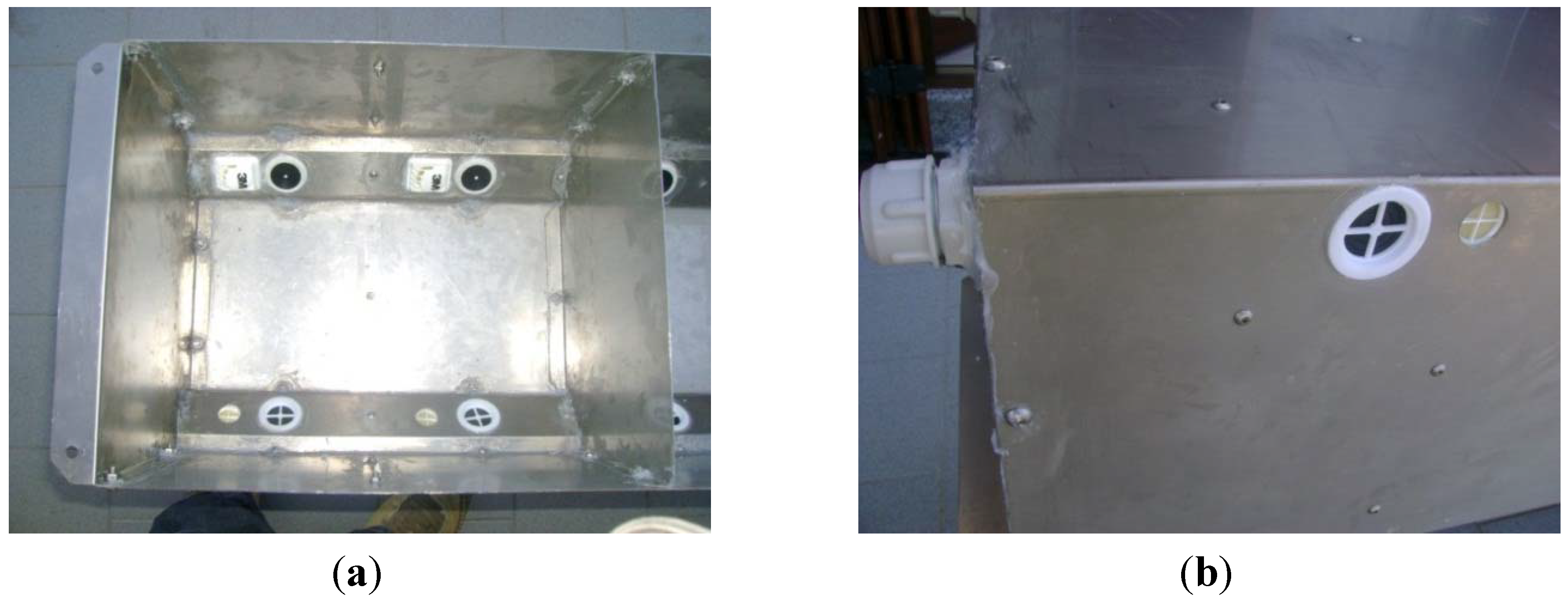

4.4. Chamber Transfer Function
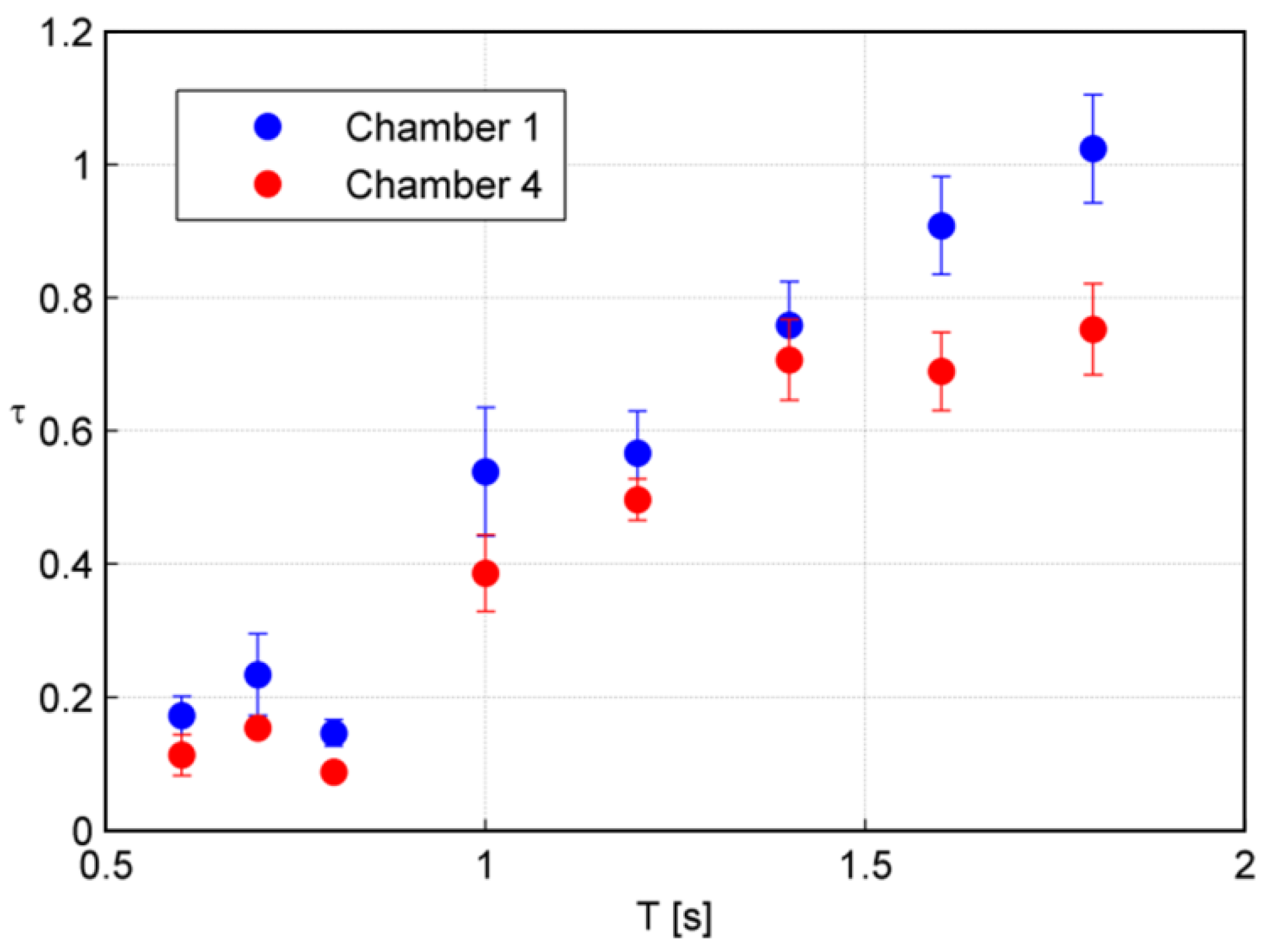
5. Numerical Model
5.1. Air Circuit
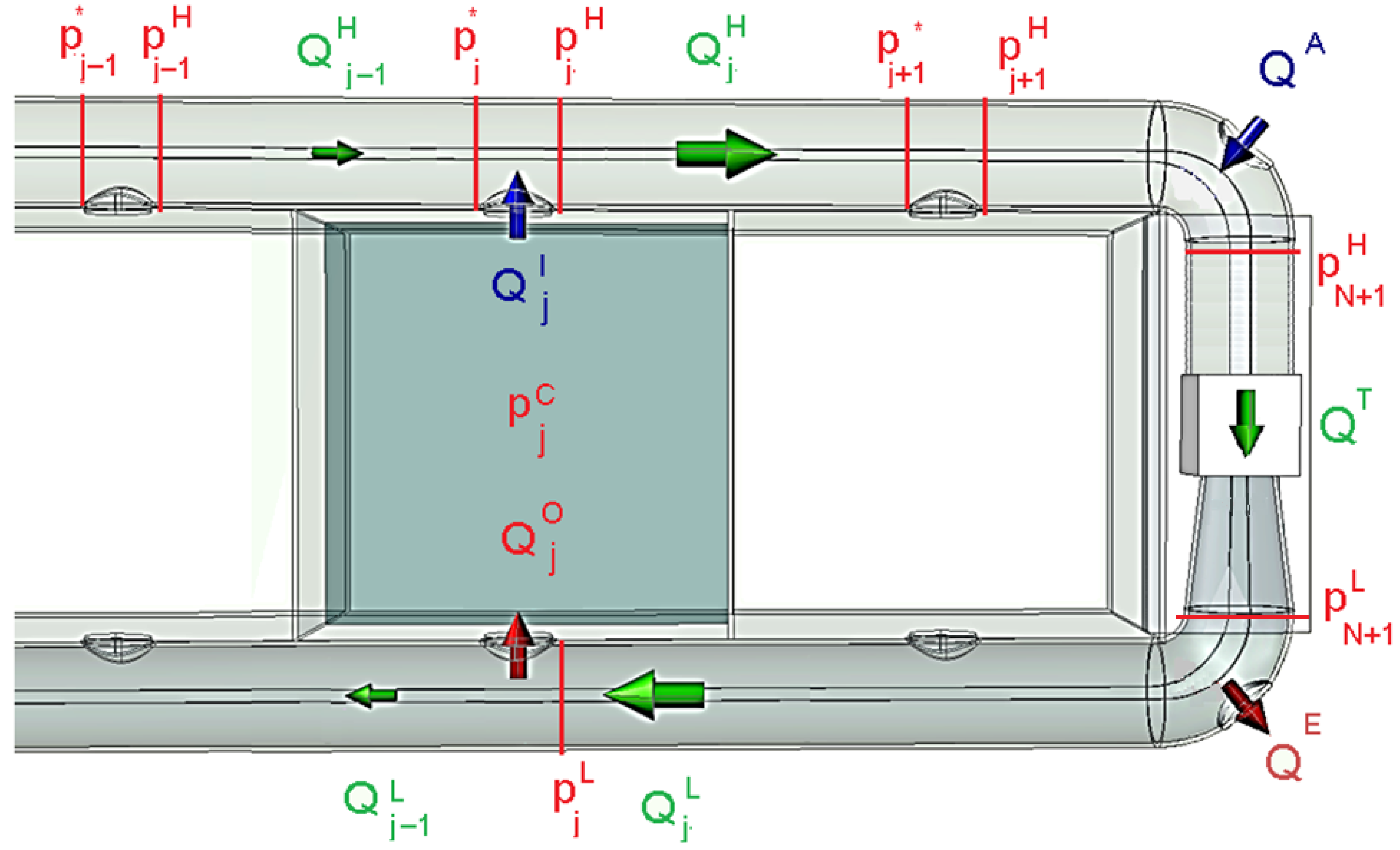

5.2. Flow between Chambers and Main Ducts
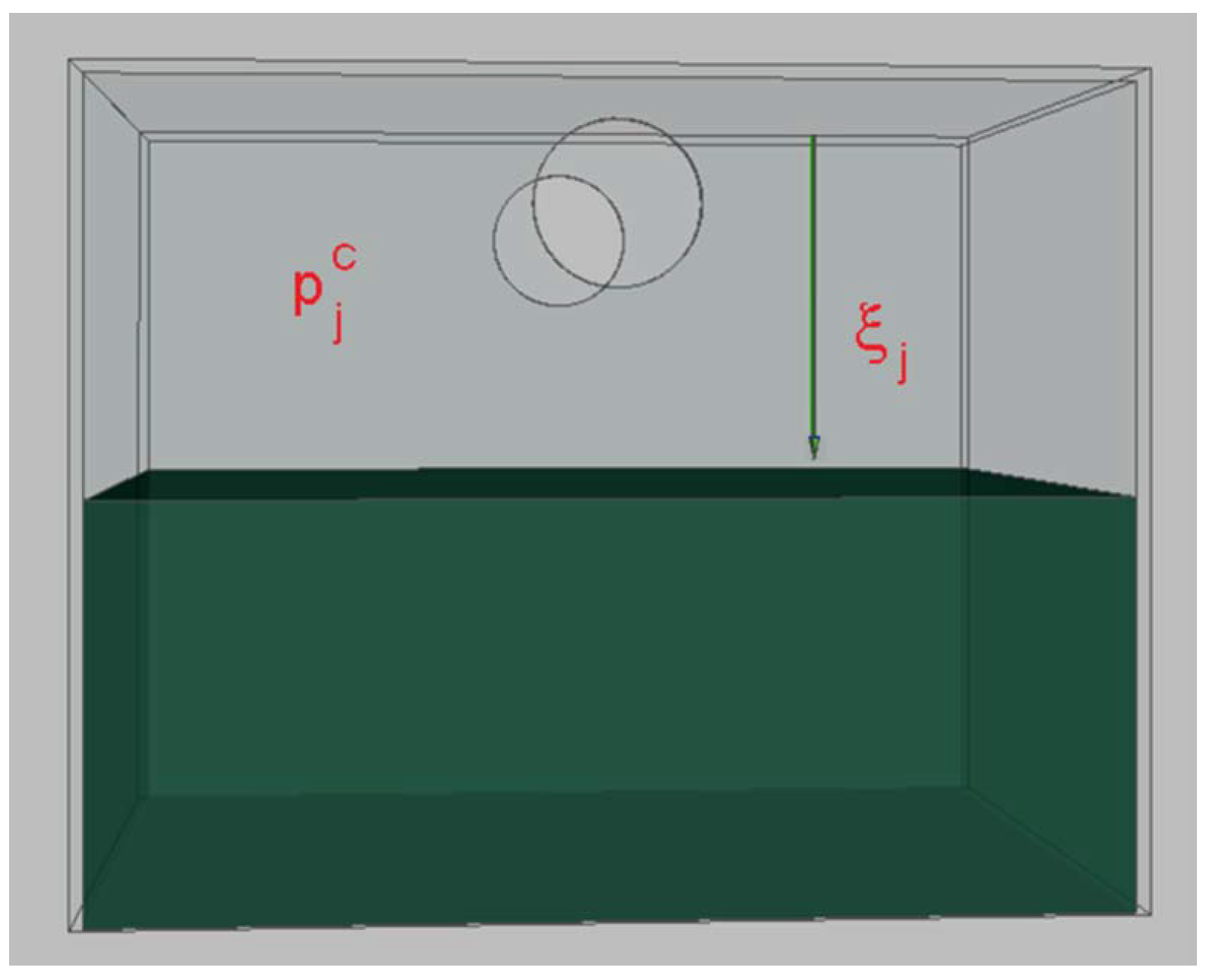
5.3. Solution Procedure
5.4. Interpretation of Experimental Results
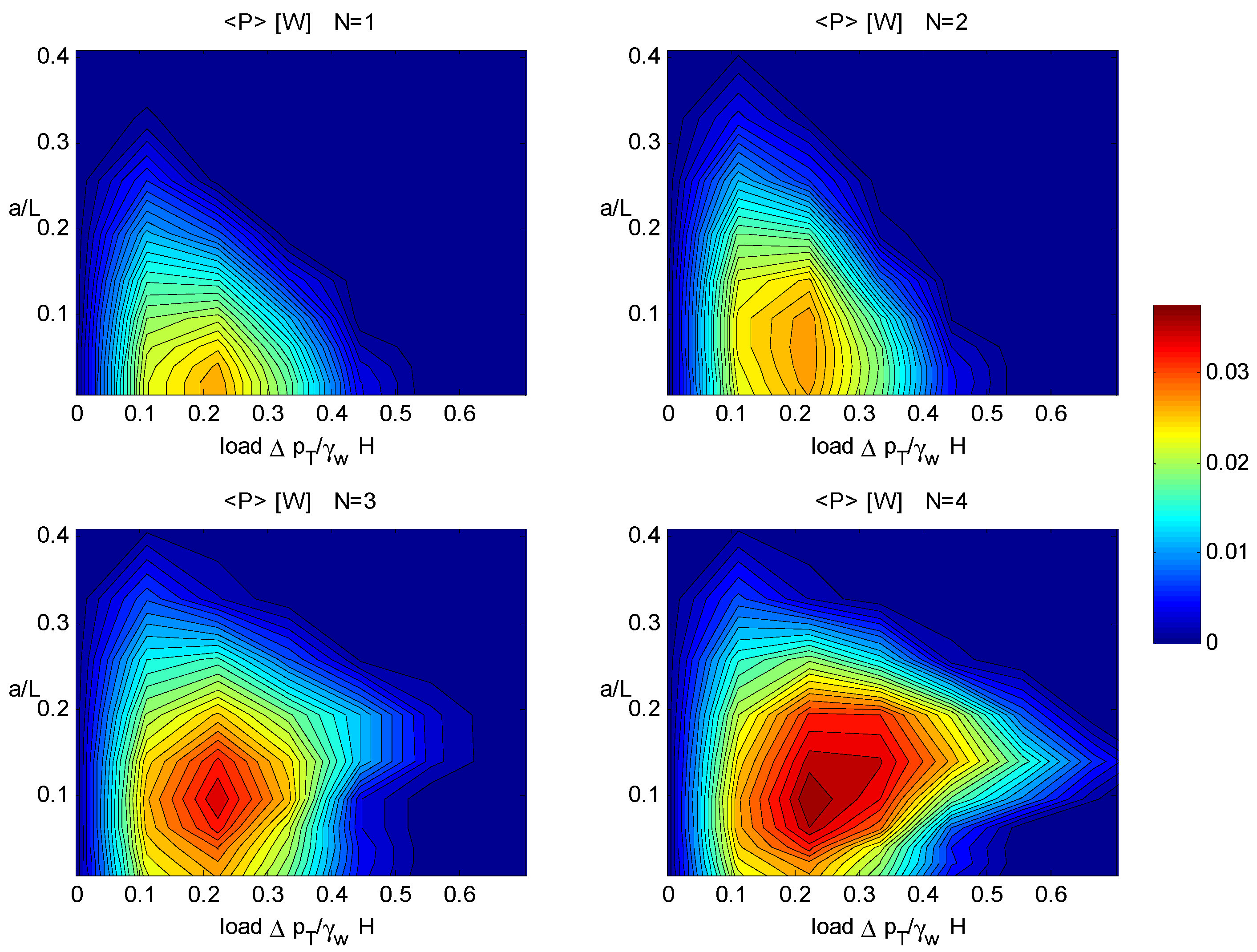

5.5. Capture Width for Improved SeaBreath
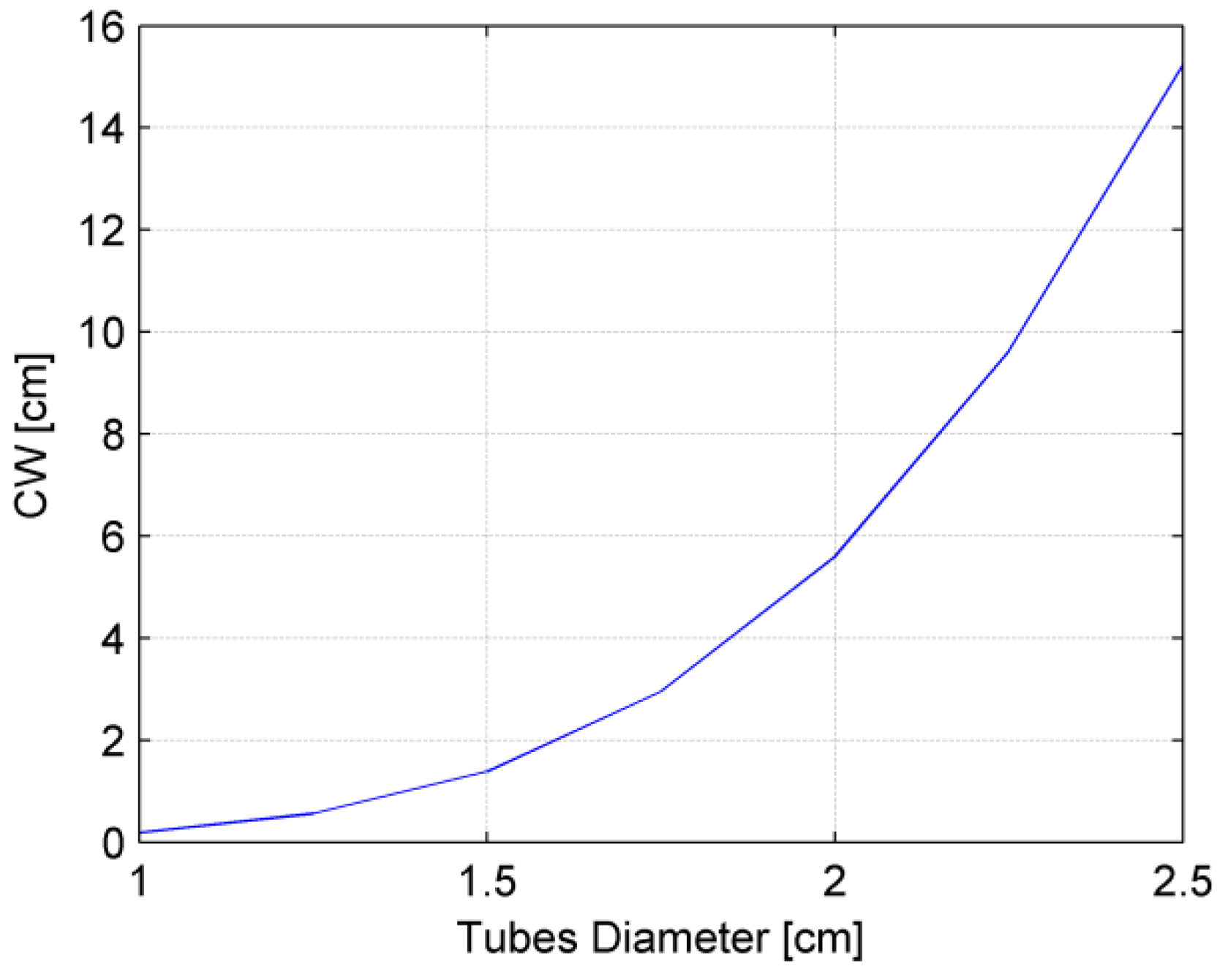
6. Application

| Wavegruop (n°) | Tmo (s) | Power (W/m) | CW (m) | Producedenergy (W) |
|---|---|---|---|---|
| 1 | calmsea | 0 | 0.0 | 0 |
| 2 | 1.96 | 1 | 0.1 | 0 |
| 3 | 2.48 | 6 | 0.1 | 0 |
| 4 | 3.00 | 27 | 0.1 | 2 |
| 5 | 3.63 | 94 | 0.2 | 14 |
| 6 | 4.17 | 101 | 1.1 | 106 |
| 7 | 4.59 | 120 | 2.3 | 271 |
| 8 | 5.05 | 159 | 2.4 | 382 |
| 9 | 5.55 | 220 | 2.6 | 576 |
| 10 | 6.11 | 305 | 3.0 | 915 |
| 11 | 6.72 | 380 | 2.9 | 1111 |
| 12 | 7.39 | 438 | 2.9 | 1248 |
| 13 | 8.13 | 459 | 2.9 | 1309 |
| 14 | 8.94 | 224 | 2.9 | 637 |
| 15 | 9.84 | 12 | 2.9 | 33 |
| 16 | 10.83 | 0 | 2.9 | 0 |
| Total: | 6605 | |||
7. Conclusions
Notation:
| a | Chamber length |
| D | Diameter of the duct |
Incident wave height | |
| j | Index for chambers (1 is closest to incident waves, N the closest to the turbine) |
Length of the j-th branch of the duct | |
| LT | Length of the circuit connecting the high and low pressure ducts to the turbine |
Air discharge in the j-th branch of the high pressure duct | |
Inflow air discharge through j-th valve | |
Air discharge in the j-th branch of the low pressure duct | |
Outflow air discharge through the j-th valve | |
| QA | Inflow air discharge through the valve that opens the circuit to the atmosphere (depending on ) |
| QE | Outflow air discharge from the valve that opens the circuit to the atmosphere (depending on ) |
Air discharge through the turbine | |
Air pressure at upstream node j, in the high pressure duct | |
Air pressure at downstream node j, in the high pressure duct | |
Air pressure at downstream node j, in the low pressure duct | |
Air pressure in chamber j | |
| V | Air volume in the chambers |
| ΔM | Head loss (load) through the turbine |
| λ | Darcy–Weisbach resistance coefficient |
| ξ | Distance between ceiling of device and water level in the chamber |
Air density | |
Linear transfer function between incident wave and height in chamber j | |
Experimentally based transfer function from wave height to level in open chamber j | |
Experimentally based transfer function from wave height to level in sealed chamber j | |
Height (double amplitude) of i-th chamber pressure fluctuation within a wave period | |
Pipe cross section |
Acknowledgments
Conflicts of Interest
References
- Kofoed, J.P.; Frigaard, P. Development of wave energy devices: The Danish case/the dragon of nissum bredning. J. Ocean Technol. 2009, 4, 83–96. [Google Scholar]
- Falcão, A.F.O. Wave energy utilization: A review of the technologies. Renew. Sustain. Energy Rev. 2012, 14, 899–918. [Google Scholar] [CrossRef]
- Boccotti, P. Caisson breakwaters embodying an OWC with a small opening-part I: Theory. Ocean Eng. 2007, 34, 806–819. [Google Scholar] [CrossRef]
- Boccotti, P.; Filianoti, P.; Fiamma, V.; Arena, F. Caisson breakwaters embodying an OWC with a small opening-part II: A small-scale field experiment. Ocean Eng. 2007, 34, 820–841. [Google Scholar] [CrossRef]
- Arena, F.; Filianoti, P. Small-scale field experiment on a submerged breakwater for absorbing wave energy. J. Waterw. Port Coast. Ocean Eng. 2007, 133, 161–167. [Google Scholar] [CrossRef]
- Martinelli, L. Wave Energy Converters under Mild Wave Climates. In Proceedings of the Marine Technology Society and the Institute of Electrical and Electronics Engineers (MTS/IEEE/MTS) Oceans Conference, Kona, HI, USA, 19–22 September 2011; p. 8.
- Archetti, R.; Bozzi, S.; Passoni, G. Feasibility Study of a Wave Energy Farm in the Western Mediterranean Sea: Comparison among Different Technologies. In Proceedings of the 30th International Conference on Ocean, Offshore and Arctic Engineering (OMAE2011), Rotterdam, The Netherlands, 19–24 June 2011.
- Vicinanza, D.; Margheritini, L.; Kofoed, J.P.; Buccino, M. The SSG wave energy converter: Performance, status and recent developments. Energies 2012, 5, 193–226. [Google Scholar] [CrossRef]
- Zanuttigh, B.; Angelelli, E. Experimental investigation of floating wave energy converters for coastal protection purpose. Coast. Eng. 2013, 80, 148–159. [Google Scholar] [CrossRef]
- Vicinanza, D.; Cappietti, L.; Contestabile, P. Assessment of Wave Energy around Italy. In Proceedings of the 8th European Wave and Tidal Energy Conference Series, Uppsala, Sweden, 7–10 September 2009.
- Vicinanza, D.; Cappietti, L.; Ferrante, V.; Contestabile, P. Estimation of the wave energy in the Italian offshore. J. Coast. Res. 2011, 64, 613–617. [Google Scholar]
- Corsini, S.; Franco, L.; Inghilesi, L.; Piscopia, R. L’Atlante delle Onde nei Mari Italiani/Italian Wave Atlas; APAT e Università di Roma Tre: Roma, Italy, 2004. [Google Scholar]
- Filianoti, P. Wave Energy Availability in Different Areas of the World. In Proceedings of the 27th Convegno di Idraulica e Costruzioni Idrauliche, Genova, Italy, 12–15 September 2000.
- Piscopia, R.; Corsini, S.; Inghilesi, R.; Franco, L. Misure Strumentali di Moto Ondoso della Rete Ondametrica Nazionale: Analisi Statistica Aggiornata degli Eventi Estremi [in Italian]. In Proceedings of the 28th Convegno di Idraulica e Costruzioni Idrauliche, Potenza, Italy, 16–19 September 2002.
- Liberti, L.; Carillo, A.; Sannino, G. Wave energy resource assessment in the Mediterranean, Italian prospective. Renew. Energy 2013, 50, 938–949. [Google Scholar] [CrossRef]
- Gaillard, P.; Ravazzola, P.; Kontolios, Ch.; Arrivet, L.; Athanassoulis, G.A.; Stefanakos, Ch.N.; Gerostathis, Th.P.; Cavaleri, L.; Bertotti, L.; Sclavo, M.; et al. Wind and Wave Atlas of the Mediterranean Sea; Western European Armaments Organization (WEAO) Research Cell, Western European Union: Brussels, Belgium, 2004. [Google Scholar]
- Vannucchi, V.; Cappietti, L.; Falcão, A.F.O. Estimation of the Offshore Wave Energy Potential of the Mediterranean Sea and Propagation toward a Nearshore Area. In Proceedings of the 4th International Conference on Ocean Energy (ICOE), Dublin, Ireland, 17–19 October 2012; pp. 1–5.
- Cavaleri, L.; Bertotti, L. The improvement of modeled wind and waves fields with increasing resolution. Ocean Eng. 2006, 33, 553–565. [Google Scholar] [CrossRef]
- Cavaleri, L.; Sclavo, M. The calibration of wind and wave model data in the Mediterranean Sea. Coast. Eng. 2006, 53, 613–627. [Google Scholar] [CrossRef]
- Ruol, P.; Martinelli, L.; Iommi, R. Mappatura Dell’ Energia Ondosa in Italia ai Fini del Possibile Sfruttamento Tramite Convertitori Ancorati al Largo [in Italian]. In Proceedings of Acqua ed Energia dell’ Accademia dei Lincei, Roma, Italy, 22 March 2011; pp. 109–116.
- Seabreath Home Page. Available online: https://www.seabreath.it (accessed on 30 March 2013).
- Thorpe, T.W. The Wave Energy Programme in the UK and the European Wave Energy Network. In Proceedings of the 4th Wave Energy Conference, Aalborg, Denmark, 4–6 December 2000; pp. 19–27.
- Kofoed, J.P.; Frigaard, P. Hydraulic Evaluation of the LEANCON Wave Energy Converter; DCE Technical Report No. 45; Department of Civil Engineering, Aalborg University: Aalborg, Denmark, 2008. [Google Scholar]
- Nautilus Footage and Testing in Moreton Bay. Available online: https://www.youtube.com/watch?v=8HYUR6Jv2nw (accessed on 30 March 2013).
- Ruol, P.; Martinelli, L.; Pezzutto, P. Formula to predict transmission for π-type floating breakwaters. J. Waterw. Port Coast. Ocean Eng. 2013, 139, 1–8. [Google Scholar] [CrossRef]
- Canale, G. Ottimizzazione di un Convertitore di Energia Ondosa a Colonna d’Acqua Oscillante Tramite Sperimentazione in Laboratorio [in Italian]. Master’s Thesis, University of Padova, Padova, Italy, 2010; p. 196. [Google Scholar]
- Mei, C.C.; Stiassnie, M.; Yue, D.K.-P. Theory and Applications of Ocean Surface Waves; World Scientific: Singapore, 2005. [Google Scholar]
- Renzi, E.; Dias, F. Resonant behaviour of an oscillating energy converter in a channel. J. Fluid Mech. 2012, 701, 482–510. [Google Scholar] [CrossRef] [Green Version]
- Martinelli, L.; Zanuttigh, B.; de Nigris, N.; Preti, M. Sand bag barriers for coastal protection along the Emilia Romagna littoral, Northern Adriatic Sea, Italy. Geotext. Geomembr. 2011, 29, 370–380. [Google Scholar] [CrossRef]
- Martinelli, L.; Zanuttigh, B.; Kofoed, J.P. Selection of design power of wave energy converters based on wave basin experiments. Renew. Energy 2011, 36, 3124–3132. [Google Scholar] [CrossRef]
© 2013 by the authors; licensee MDPI, Basel, Switzerland. This article is an open access article distributed under the terms and conditions of the Creative Commons Attribution license (http://creativecommons.org/licenses/by/3.0/).
Share and Cite
Martinelli, L.; Pezzutto, P.; Ruol, P. Experimentally Based Model to Size the Geometry of a New OWC Device, with Reference to the Mediterranean Sea Wave Environment. Energies 2013, 6, 4696-4720. https://doi.org/10.3390/en6094696
Martinelli L, Pezzutto P, Ruol P. Experimentally Based Model to Size the Geometry of a New OWC Device, with Reference to the Mediterranean Sea Wave Environment. Energies. 2013; 6(9):4696-4720. https://doi.org/10.3390/en6094696
Chicago/Turabian StyleMartinelli, Luca, Paolo Pezzutto, and Piero Ruol. 2013. "Experimentally Based Model to Size the Geometry of a New OWC Device, with Reference to the Mediterranean Sea Wave Environment" Energies 6, no. 9: 4696-4720. https://doi.org/10.3390/en6094696





